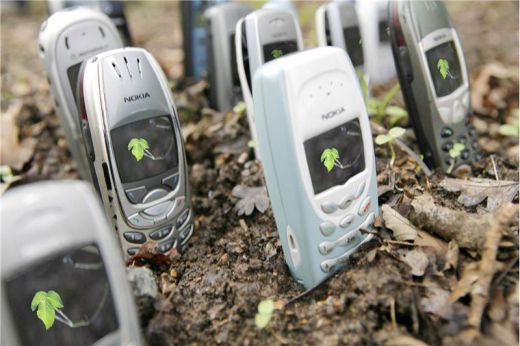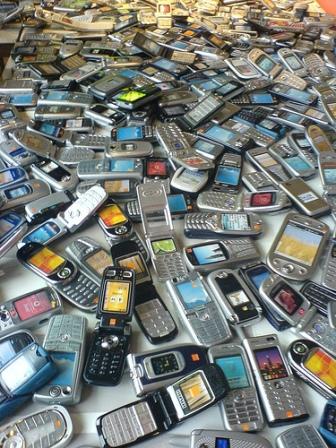Recycle Mobile Phones Biography
Source(google.com.pk)
There are a number of phones on the market that claim to be green. Here is a review of four leading manufacturers and the greenest mobile phones in the world.
Four Blackberrys, two Apples, six Samsungs, and five Nokias
According to a United Nations Telecom Agency report, there are about 6 billion cell phone subscribers around the globe. With low recycling rates and the average cell phone life being around 18 months, this means billions of phones have been thrown away around the world..
The Key impacts of telecommunications companies include water use, greenhouse-gas emissions, waste and disposal. Combined, these impacts account for more than 85 percent of the total environmental footprint of telecommunication companies.
The environmental impacts of e-waste generated by discarded electronic goods is a growing problem. It is estimated that e-waste is growing at a rate of 40 million tons per year. A United Nations Environmental Programme (UNEP) report titled, “Recycling – from e-Waste to Resources,’ indicates that 20 – 50 million tons of e-waste is generated each year worldwide.
Consumers dispose of more than 350,000 mobile phones every day. According to the EPA, 141 million mobile phones were discarded in 2009 and only 12 million of those were collected for recycling. Roughly 100 million mobile phones are discarded in Europe and China each year.
The global consumption and waste generated by mobile phones has several deleterious environmental impacts. Much of this waste is deposited in landfills or incinerated, releasing toxins and other pollutants. Increasingly, e-waste is also being exported to developing countries, where it is dismantled under poorly regulated conditions. The plastic used in cell phone can take between 500 to 1000 years to biodegrade; additionally, plastic manufacturing uses approximately 7 percent of the world’s fossil fuels.
However, several telecommunication companies are addressing these issues with programs like end-of-life product-management. These programs take back and recycle mobile phones. Some leading companies are going further by incorporating eco-design criteria such as material selection and energy efficiency into their product design. A United Nations-sponsored program, Solving the e-Waste Problem (StEP), is considered a best practice.
Pressure campaigns are driving cells phones to be more transparent and more sustainable. An Environmental Leader article reports that Friends of the Earth called on Apple and Samsung to tell consumers where they source the tin used in their mobile phones, as part of the UK-based advocacy group’s Make It Better campaign.
According to a 2010 study, 44 percent of consumers consider a device’s environmental credentials when purchasing a smartphone. There is anecdotal evidence to suggest that consumers are increasingly demanding better management of environmental impacts from their cell phone manufacturers. Apple found this out the hard way when consumers forced the company to reinstate its use of the Electronic Product Environmental Assessment Tool for its products after it was dropped.
By 2017, Treehugger estimates that 400 million green cell phones, or those made with at least 50 percent recycled content, will be shipped. Greener mobile phones are very important because they employ more responsible raw materials and are recycled rather than discarded.
Recycle Mobile Phones Phone Wallpapers Icon Backgrounds Cases Wallpapers Hd Logo Call Numbers Booth Symbol Images Phones

Recycle Mobile Phones Phone Wallpapers Icon Backgrounds Cases Wallpapers Hd Logo Call Numbers Booth Symbol Images Phones

Recycle Mobile Phones Phone Wallpapers Icon Backgrounds Cases Wallpapers Hd Logo Call Numbers Booth Symbol Images Phones

Recycle Mobile Phones Phone Wallpapers Icon Backgrounds Cases Wallpapers Hd Logo Call Numbers Booth Symbol Images Phones

Recycle Mobile Phones Phone Wallpapers Icon Backgrounds Cases Wallpapers Hd Logo Call Numbers Booth Symbol Images Phones

Recycle Mobile Phones Phone Wallpapers Icon Backgrounds Cases Wallpapers Hd Logo Call Numbers Booth Symbol Images Phones

Recycle Mobile Phones Phone Wallpapers Icon Backgrounds Cases Wallpapers Hd Logo Call Numbers Booth Symbol Images Phones

Recycle Mobile Phones Phone Wallpapers Icon Backgrounds Cases Wallpapers Hd Logo Call Numbers Booth Symbol Images Phones

Recycle Mobile Phones Phone Wallpapers Icon Backgrounds Cases Wallpapers Hd Logo Call Numbers Booth Symbol Images Phones

Recycle Mobile Phones Phone Wallpapers Icon Backgrounds Cases Wallpapers Hd Logo Call Numbers Booth Symbol Images Phones

No comments:
Post a Comment